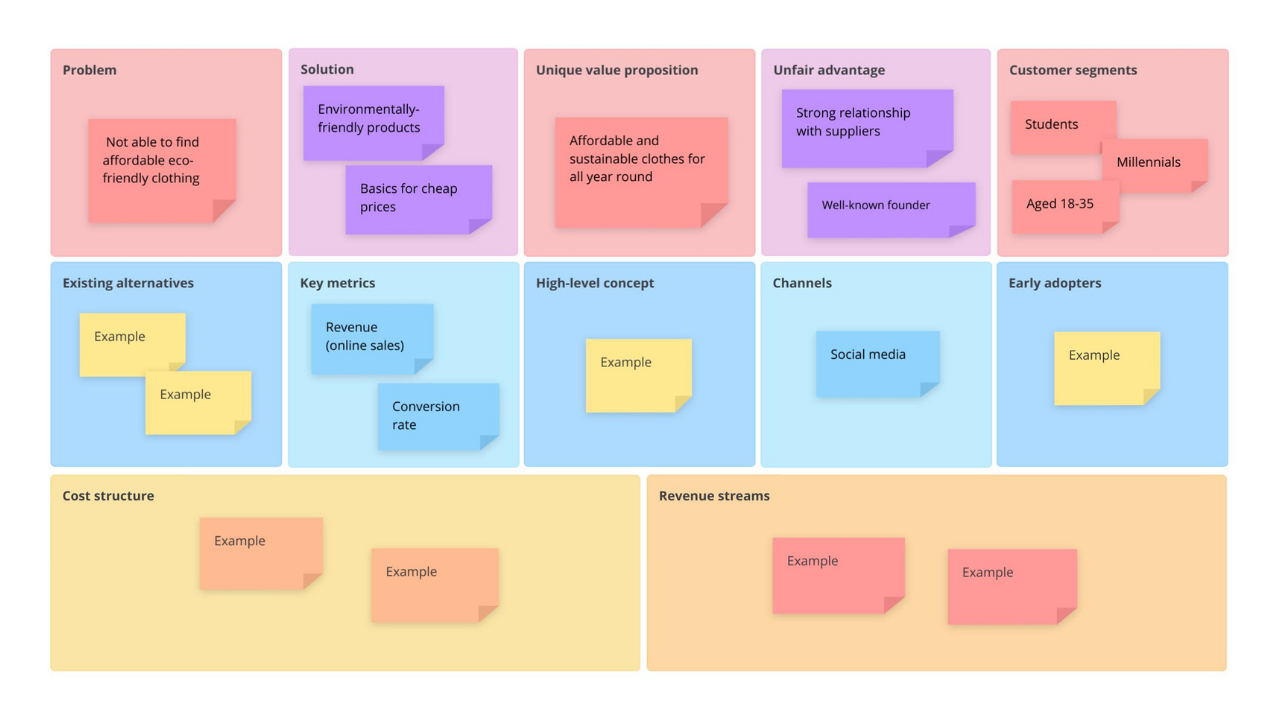Lean Canvas template

Ayoa’s Lean Canvas template will enable you to embrace the popular Lean Start-up method by creating a quick yet effective business plan.
What is a Lean Canvas and what is the Lean Start-up method?
‘Lean Start-up’ is a methodology that focuses on getting products and services into the hands of your customers as quickly as possible, and it does this by using testing to shorten development cycles and eliminate waste. The Lean Canvas (which was created by the entrepreneur and Running Lean author, Ash Maurya) allows you to apply this thinking to various projects, so you can replace extensive and time-consuming business plans with a simplified one-page version. This enables you to simplify and shorten the process of assessing business opportunities, while still ensuring that you are able to make a justified and informed decision.
The Lean Canvas works by allowing you to break down your ideas into key assumptions to be explored as part of your wider business strategy. Similarly to the SWOT and PEST Analysis frameworks, a Lean Canvas encourages you to consider both internal and external factors that can impact your business.
Why use the Lean Canvas template?
Our Lean Canvas template provides you with everything you need to create a simplified, yet effective business plan. By encouraging you to replace writing an extensive business plan with condensing your ideas into bite-sized assumptions on one page, you can make the process of assessing opportunities more time and cost-effective. As a Lean Canvas will encourage you to brainstorm creatively and consider both the threats and opportunities to your business (which can be either internal or external), you are encouraged to consider all angles, so you can make better business decisions in less time.
With our Lean Canvas template helping you to put all of your ideas on one page, you can also find the information you need quickly, which can make it easier to put your ideas into action.
How to use our Lean Canvas template
Ready to embrace the Lean Start-up method in your planning? Our Lean Canvas template is already populated with the columns you need, and we’ve even included some example sticky notes to help you get started!
To access the template, sign up to Ayoa. Once you've signed up, navigate to the homepage to create a new whiteboard, mind map or task board and choose this template from the library.
PROBLEM. In the first box, start by defining the problem (or problems) you’re trying to solve. What are the pain points of your target customer? Try to determine how common these problems are and whether consumers would be willing to pay to fix this issue. Use sticky notes to add these ideas to the template.
SOLUTION. In this section, summarize your business offering and the features you offer that can help to solve these problems. Do your competitors also have products or services that can address these pain points?
UNIQUE VALUE PROPOSITION. For this section, the clue is in the name – what makes your business unique? How many competitors do you have and how do they compare? What are you able to offer that others are not? What else can you do to ensure you stand out from your competition?
UNFAIR ADVANTAGE. Similar to the previous section, consider what gives you an edge over your competition. What can you do to ensure that your competition can’t copy you? One example might be that you’re utilizing new technologies that they don’t yet have access to.
CUSTOMER SEGMENTS. Now it’s time to think about who your customers actually are. Think about their key demographics (such as their typical age range, gender, education level, and relationship status). You should also ask yourself: What are their interests? What are their behaviors? Try to identify a few different and specific personas.
EXISTING ALTERNATIVES. Going back to your customers’ pain points (which you identified earlier), think about what alternatives are already out there that can address these problems. For example, in the case of a marketplace app where users can buy and sell used items, you already have the likes of affordable retails stores, eBay, Facebook Marketplace, and physical yard sales to compete with.
KEY METRICS. For any business, it’s important to know whether your products and services are performing well. With that in mind, what are the Key Performance Indicators (KPIs) that will help you determine whether your business is successful? Some metrics you may want to consider include customer engagement (such as your number of social media followers), cost per acquisition, customer lifetime value, and revenue.
HIGH-LEVEL CONCEPT. In this section, outline your business’s value proposition (the promise of value you will deliver) as briefly and simply as possible. Try to condense this into a single short sentence.
CHANNELS. As the name suggests, now you need to list the channels you’ll use to reach out to your customers and advertise your products or services. Is it marketing emails, television adverts, or specific social media channels? Refer back to the notes you made on your customers and where you’re most likely to find them; in the case of a clothing brand for millenials, this might be through more visual social media platforms, such as Pinterest and Instagram.
EARLY ADOPTERS. Use this section of the template to further develop the profile of your ideal customer, aiming to be as specific as possible.
COST STRUCTURE. Next up, list all of your variable and fixed operational costs. Research the costs of potential suppliers, manufacturing, advertising, shipping your product to customers, and anything else that may be relevant to your business.
REVENUE STREAMS. Finally, it’s time to think about your revenue in more detail. Consider your various revenue streams – is it through the sale of physical products or a subscription to an app that needs to be renewed every month or year? Is it a combination of a few different revenue streams? What is the lifetime value of your product or service offering? How much value does each customer bring? Is it recurring?
Now that you’ve filled out each section of the template, review the information you’ve gathered and use it to spot key strengths and weaknesses in your business. You can then begin to formulate an effective strategy going forward.









